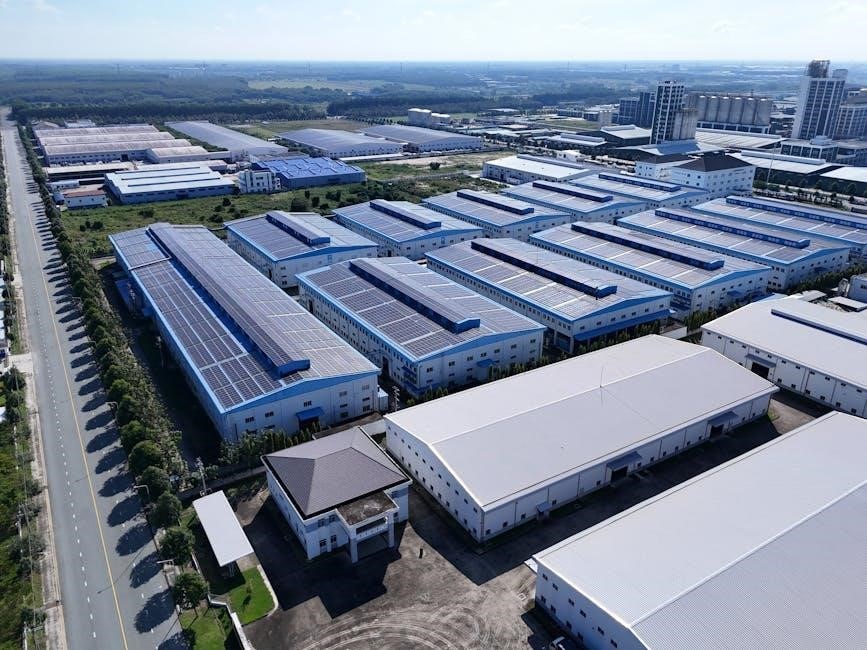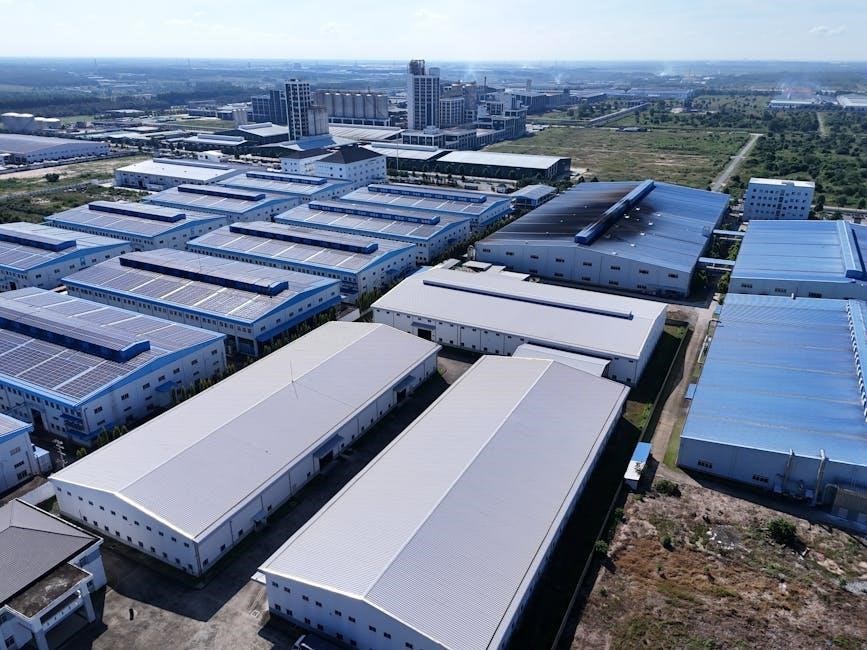
kinh dia tang pdf
Economic heritage encompasses cultural and natural resources that support economic growth and sustainable development. It highlights the value of preserving traditions, landscapes, and historical sites for future generations.
Definition and Significance of Economic Heritage
Economic heritage refers to the cultural and natural resources that contribute to a region’s economic development and identity. It encompasses tangible assets like historical sites and intangible traditions, fostering tourism and sustainable growth. The significance lies in its ability to preserve cultural identity while generating revenue through heritage tourism and related industries. By leveraging these resources, communities can create livelihoods and promote environmental sustainability, ensuring a balance between economic progress and cultural preservation. Economic heritage thus acts as a bridge between the past and future, driving development while honoring tradition.
The Role of Cultural and Natural Heritage in Economic Development
Cultural and natural heritage play pivotal roles in economic development by attracting tourism, fostering innovation, and creating jobs; These resources, such as historical sites and natural landscapes, serve as magnets for visitors, boosting local economies through accommodations, dining, and souvenirs. Additionally, they inspire creativity in industries like arts and crafts, enhancing product uniqueness. Heritage conservation also encourages sustainable practices, preserving ecosystems and cultural traditions for future generations. By integrating heritage into development strategies, regions can achieve economic growth while maintaining their unique identity and environmental balance, ensuring long-term prosperity and cultural preservation.
Economic Heritage and Its Impact on Growth
Economic heritage drives growth by leveraging cultural and natural assets, fostering tourism, creating jobs, and promoting sustainable development, while preserving cultural identity and environmental balance.
Case Studies: Heritage Tourism in Vietnam and Its Economic Contributions
Heritage tourism in Vietnam has emerged as a significant driver of economic growth, attracting millions of visitors annually. Sites like Hạ Long Bay and Hội An Ancient Town showcase the country’s rich cultural and natural heritage, generating substantial revenue. According to recent data, these destinations welcomed over 5 million visitors in 2023, contributing billions of đồng to the economy. Heritage tourism also fosters job creation in hospitality, tourism services, and handicraft industries, benefiting local communities. By preserving Vietnam’s unique heritage, the tourism sector ensures sustainable development while promoting cultural identity and environmental conservation, making it a cornerstone of the nation’s economic strategy.
Investment in Heritage Conservation as a Driver for Economic Growth
Investment in heritage conservation is a powerful catalyst for economic growth, fostering job creation and attracting both domestic and international investment. By preserving cultural and natural heritage, governments and private sectors can stimulate tourism, enhance local industries, and promote sustainable development. For instance, Vietnam’s recognition of Phở as a UNESCO-recognized dish has boosted cultural tourism, while Hue’s investment in cultural industries supports economic resilience. Urban heritage conservation also encourages environmental protection and community engagement, ensuring long-term benefits for future generations while driving economic progress.
Economic Valuation of Heritage Sites
Economic valuation of heritage sites involves assessing their cultural and natural worth to determine their potential for sustainable development and future generations’ benefit.

Methods for Assessing the Economic Value of Cultural and Natural Heritage
Assessing the economic value of cultural and natural heritage involves various methods, including contingent valuation, cost-benefit analysis, and hedonic pricing. These techniques help quantify intangible benefits, such as cultural significance and environmental impact, alongside direct economic contributions like tourism revenue. Contingent valuation surveys gauge willingness to pay for heritage preservation, while cost-benefit analysis compares conservation costs with societal gains. Hedonic pricing evaluates how heritage sites influence property values. These methods provide policymakers with data-driven insights to balance conservation and development, ensuring sustainable use of heritage resources for economic and cultural enrichment.
Examples of Economic Valuation of UNESCO World Heritage Sites in Asia
UNESCO World Heritage Sites in Asia, such as Ha Long Bay in Vietnam and Angkor Wat in Cambodia, exemplify economic valuation through tourism and cultural impact. Ha Long Bay generates significant revenue from tourism, supporting local economies. Similarly, Hoi An Ancient Town in Vietnam leverages its cultural heritage to attract visitors, boosting local businesses. These sites are valued using methods like cost-benefit analysis and contingent valuation, demonstrating their economic and cultural importance. Such heritage sites contribute substantially to national GDP and employment, underscoring their role in sustainable development and economic growth.

Challenges and Risks in Heritage Management
Heritage management faces challenges like urbanization, environmental degradation, and economic pressures, threatening cultural identity and historical sites’ preservation, requiring balanced strategies for sustainable conservation.
Urbanization and the Loss of Cultural Identity
Urbanization and the Loss of Cultural Identity
Urbanization often leads to the erosion of cultural identity as traditional sites are replaced by modern infrastructure. In Vietnam, rapid urban growth threatens ancient villages like Hùng Lô, which still preserves valuable cultural heritage. The loss of historical landmarks and cultural practices undermines community identity and heritage preservation efforts. Urban development must balance progress with the protection of cultural assets to ensure sustainable growth and maintain the unique characteristics of each region. This challenge requires innovative strategies to integrate heritage conservation into urban planning, preserving cultural identity for future generations while addressing economic and social needs.
Environmental and Economic Risks in Managing Heritage Sites
Managing heritage sites faces dual challenges: environmental degradation and economic instability. Pollution, climate change, and over-tourism threaten the integrity of cultural and natural heritage, while economic risks include insufficient funding and revenue management issues. In Vietnam, sites like Tràng An and Huế struggle with balancing conservation and tourism, risking environmental damage and economic unsustainability. Over-reliance on tourism income also exposes heritage sites to market fluctuations. These risks require integrated strategies to ensure sustainable management, protecting both the environment and economic viability for future generations while preserving cultural and natural assets.

Heritage Tourism as a Sustainable Economic Strategy
Heritage tourism boosts local economies through sustainable practices, fostering job creation and cultural preservation while promoting environmental stewardship for long-term economic and societal benefits.
Developing Tourism Products Based on Cultural and Natural Heritage
Developing tourism products based on cultural and natural heritage involves creating unique experiences that showcase a region’s history, traditions, and environmental assets. This includes guided tours, workshops, and festivals that highlight local customs, craftsmanship, and historical sites. For example, Vietnam’s heritage sites like Hạ Long Bay and Huế’s imperial city attract millions of visitors annually. By integrating digital tools, such as virtual reality tours, the appeal of these products can be enhanced. Sustainable practices ensure that tourism benefits local communities while preserving heritage for future generations, making it a cornerstone of economic growth and cultural conservation.
Sustainable Tourism Practices to Preserve Heritage for Future Generations
Sustainable tourism practices are essential for preserving cultural and natural heritage while supporting economic growth. These practices include eco-friendly accommodations, waste reduction, and educating tourists about heritage conservation. Community involvement ensures that local residents benefit economically and culturally. For instance, Vietnam’s heritage sites like Huế and Hạ Long Bay implement measures to limit environmental impact while promoting cultural awareness. By adopting sustainable tourism, heritage sites can maintain their integrity for future generations, ensuring a balance between economic development and environmental preservation. This approach fosters a deeper appreciation of heritage and creates a lasting legacy for global heritage conservation efforts.

Urban Heritage and Economic Revitalization
Urban heritage plays a vital role in revitalizing economies by preserving historic areas and transforming them into vibrant hubs for business, tourism, and cultural activities, fostering sustainable growth.
Revitalizing Urban Areas Through Heritage Conservation
Heritage conservation in urban areas serves as a catalyst for economic revitalization by preserving historical sites and cultural landmarks. This process attracts tourism, boosts local businesses, and fosters community pride, creating sustainable economic opportunities. Urban heritage sites, such as historic districts and traditional architecture, are transformed into vibrant hubs that blend the past with modern development. By integrating cultural preservation with urban planning, cities can maintain their unique identity while driving economic growth. This approach ensures that heritage sites remain relevant and dynamic, contributing to the socio-economic well-being of urban populations.
Examples of Successful Urban Heritage Projects in Southeast Asia

Southeast Asia boasts numerous urban heritage projects that blend preservation with economic growth; Hoi An Ancient Town in Vietnam, a UNESCO World Heritage Site, exemplifies successful heritage tourism, attracting millions annually. Similarly, Penang George Town in Malaysia revitalized its colonial architecture, fostering cultural tourism and local businesses. Singapore’s Chinatown and Little India have preserved ethnic heritage while integrating modern infrastructure. These projects demonstrate how urban heritage conservation can drive economic revitalization, enhance cultural identity, and create sustainable development opportunities, setting benchmarks for other regions to emulate.
Heritage and Sustainable Development
Heritage conservation plays a vital role in sustainable development by preserving cultural and natural assets, fostering environmental stewardship, and promoting inclusive economic growth for present and future generations.
Linking Heritage Conservation to Environmental and Social Sustainability
Heritage conservation is deeply intertwined with environmental and social sustainability, ensuring cultural and natural assets are preserved for future generations. By integrating heritage into sustainable development strategies, communities can maintain their unique identities while addressing environmental challenges. This approach fosters social cohesion and promotes eco-friendly practices, balancing economic growth with ecological preservation. Effective conservation measures, such as safeguarding historic sites and traditional practices, contribute to biodiversity protection and climate resilience. Thus, linking heritage conservation to sustainability ensures a harmonious relationship between cultural, environmental, and social dimensions, creating a holistic framework for sustainable development.
International Frameworks for Heritage-Based Sustainable Development

International frameworks play a crucial role in promoting heritage-based sustainable development by providing guidelines and support for conserving cultural and natural assets. UNESCO’s World Heritage Convention is a cornerstone, establishing global standards for heritage protection. Initiatives like the International Council on Monuments and Sites (ICOMOS) and the World Heritage Fund offer resources and funding to safeguard heritage sites. These frameworks emphasize integrating heritage into sustainable development plans, fostering economic growth while preserving cultural identity. By aligning heritage conservation with global sustainability goals, these frameworks ensure that heritage contributes to environmental, social, and economic well-being worldwide.

Future Directions in Economic Heritage Management
Future directions in economic heritage management emphasize technological innovation and global collaboration to enhance preservation efforts and sustainable tourism, ensuring heritage sites thrive economically and culturally.
Technological Innovations in Heritage Preservation and Tourism
Technological advancements are revolutionizing heritage preservation and tourism. Digital tools like 3D scanning and augmented reality enable immersive experiences, allowing visitors to explore cultural sites remotely. Virtual reality enhances storytelling, making historical narratives more engaging. Additionally, blockchain technology ensures secure documentation and preservation of heritage assets. Mobile applications provide interactive guides, boosting tourist engagement. These innovations not only preserve cultural legacy but also attract a younger, tech-savvy audience, fostering sustainable economic growth in the heritage sector. Such technologies are pivotal in balancing preservation with modernization, ensuring heritage remains accessible and relevant for future generations.
Global Collaborations to Promote Economic Heritage
Global collaborations play a vital role in promoting economic heritage by fostering international partnerships and knowledge exchange. Organizations like UNESCO and the World Bank support cross-border initiatives to protect and leverage cultural and natural assets. These collaborations enhance tourism, creating economic opportunities for local communities. By sharing best practices, countries can develop sustainable strategies to preserve heritage while driving growth. Such efforts not only strengthen cultural identity but also build global appreciation for diverse heritage sites, ensuring their preservation for future generations and contributing to a unified approach to heritage-based economic development worldwide.
Related Posts

acls exam version c answers pdf
Get ACLS Exam Version C answers in PDF format. Free study guide, practice questions, and instant download. Prepare smarter, not harder!

explaining adhd to a child pdf
Learn how to explain ADHD to children in a simple, engaging way. Download our free PDF guide to help kids understand and manage their ADHD.

john paul jackson books pdf free download
Access John Paul Jackson’s books for free in PDF. Instantly download his spiritual teachings and revelations.